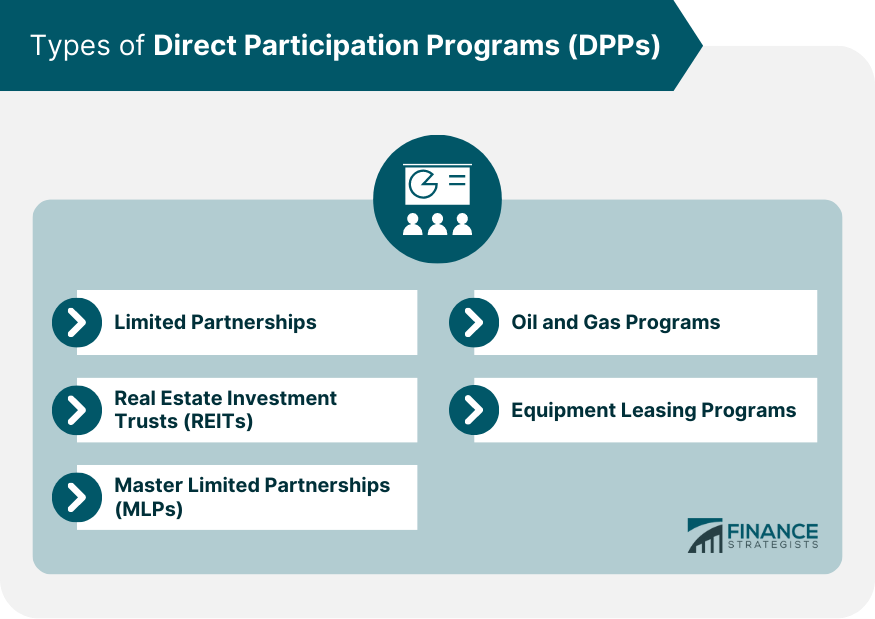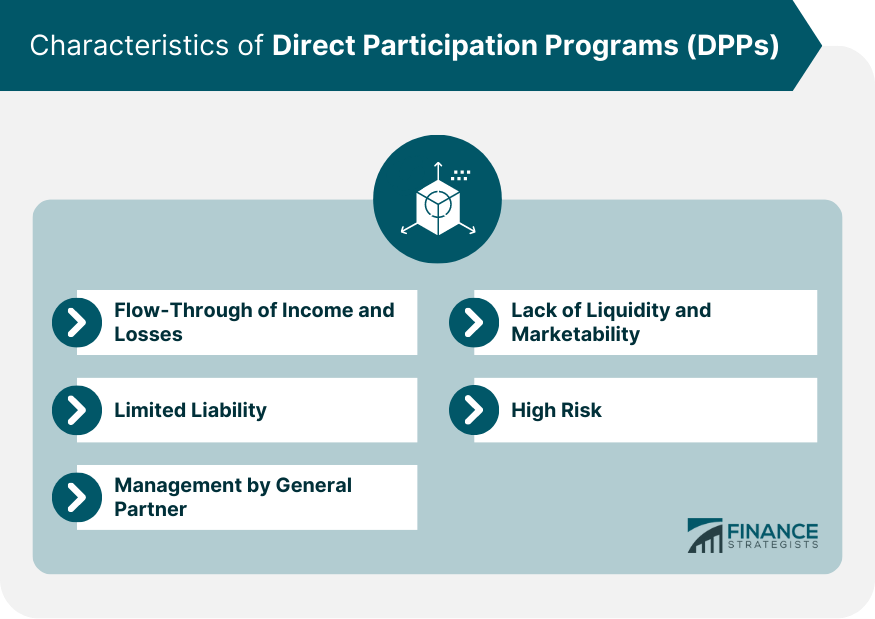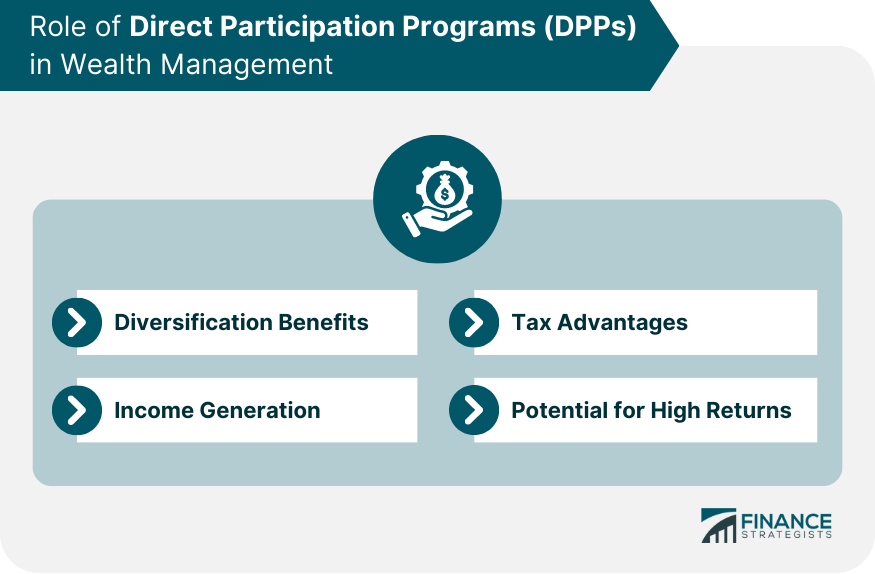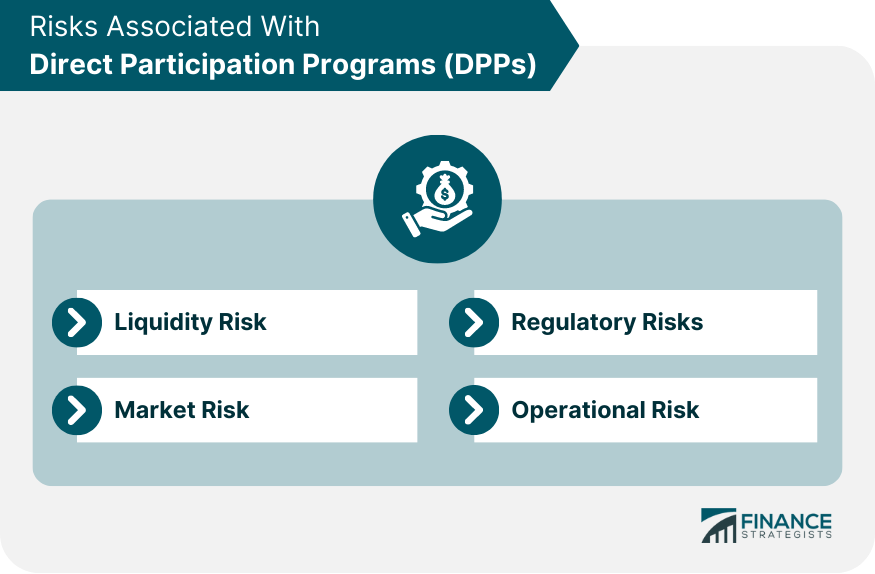Direct Participation Programs (DPPs) are non-traded investment strategies that allow investors to participate directly in a business's cash flow and taxation benefits. DPPs are typically organized as limited partnerships (LPs) or limited liability companies (LLCs), providing investors with a direct stake in the program's profits and losses. Within the realm of wealth management, DPPs offer a unique opportunity for portfolio diversification and potential tax advantages. These programs often involve investments in tangible assets like real estate or energy resources, providing an avenue for investors to partake in sectors they may otherwise be unable to access. However, they can carry substantial risk due to their illiquid nature and the potential for complete loss of invested capital. Limited Partnerships (LPs) are a common type of DPP where investors act as limited partners, contributing capital but not participating in the day-to-day management of the partnership. The general partner, who is typically the sponsor or manager of the LP, carries out the operation and management of the partnership. Non-traded Real Estate Investment Trusts (REITs) are DPPs that invest in real estate-related assets. These can include a range of property types, from commercial to residential. Investors in these programs gain exposure to the real estate market without the need to directly manage properties. Master Limited Partnerships (MLPs) are publicly traded partnerships, often in energy-related industries like oil and gas. MLPs, while trading on an exchange, maintain the tax benefits of a partnership structure. They are known for their high distribution rates, making them attractive to income-focused investors. Oil and Gas Programs are DPPs that focus on the exploration, development, and production of oil and gas reserves. These programs can provide significant tax benefits due to the high depletion and depreciation associated with these assets but also carry substantial risk due to the volatility of energy prices. Equipment Leasing Programs are DPPs that invest in business essential equipment leased to different industries. These programs benefit from stable cash flows generated from lease payments, but they also carry risks associated with the lessee's ability to make payments and the residual value of the equipment. One of the key characteristics of DPPs is the flow-through of income and losses. This means that the profits and losses of the DPP are passed directly to the investors, who report these on their personal tax returns. This structure can provide significant tax advantages for investors. Investors in DPPs typically have limited liability, which means their financial risk is limited to the amount they have invested in the program. This provides a level of protection for investors, as their personal assets are not at risk if the DPP fails. DPPs are usually managed by a general partner or sponsor who makes operational decisions on behalf of the investors. This allows investors to benefit from the expertise of experienced managers but can also lead to potential conflicts of interest. DPPs are generally illiquid investments with limited secondary markets. This can make it difficult for investors to sell their interest in the program and can lead to long holding periods. The lack of marketability can also make it difficult to accurately value the investment. Due to the nature of the underlying assets, many DPPs carry a high level of risk. Whether it be the fluctuating market values in real estate or the volatile energy prices for oil and gas programs, DPPs inherently contain elements of uncertainty. Investors must be prepared for the possibility of substantial losses. DPPs offer investors a way to diversify their portfolio by providing access to alternative asset classes not typically available through traditional investment vehicles. By investing in assets such as real estate, energy resources, or business equipment, investors can potentially lower their portfolio's overall risk. Many DPPs, such as REITs and MLPs, are designed to generate regular income distributions for investors, making them attractive for income-focused wealth management strategies. The income generated from these programs is often higher than traditional income-generating investments, such as bonds or dividend-paying stocks. The flow-through structure of DPPs allows for some potentially significant tax advantages. Investors may benefit from deductions for depreciation and costs associated with the operation of the DPP. Furthermore, distributions from certain DPPs, like MLPs, may be treated as a return of capital, reducing the investor's taxable income. While DPPs carry a high level of risk, they also offer the potential for substantial returns. This is especially true for DPPs involved in sectors like real estate and energy, where large capital gains can be realized if the assets increase in value. The potential for high returns can make DPPs an attractive component of a wealth management strategy for high-risk-tolerant investors. One of the most significant risks associated with DPPs is liquidity risk. Given the nature of the investments, DPPs often lack a readily available market to buy or sell interests, meaning investors may be unable to liquidate their investments promptly when needed. This can result in long holding periods and potential losses if an investor is forced to sell at an inopportune time. DPPs are also subject to market risk, as the value of the underlying assets can fluctuate with market conditions. This is especially true for DPPs that invest in volatile sectors like real estate and oil and gas. Market downturns can lead to significant losses in the value of the DPP, impacting investors' returns. Regulatory risks involve changes in government or industry regulations that could negatively impact a DPP. Changes in tax laws, for instance, could reduce the attractiveness of DPPs as an investment vehicle. Similarly, increased regulatory scrutiny or changes in industry standards could potentially affect the DPP's operations. Operational risks are inherent in the management and operation of a DPP. This could include risks related to the management team's expertise, the effectiveness of the DPP's business strategy, or unforeseen operational issues like accidents or natural disasters that could impact the DPP's assets. The SEC oversees the regulation of DPPs, ensuring they comply with federal securities laws. This includes the requirement that DPPs provide detailed disclosure documents to potential investors, outlining the risks and potential rewards of the investment. FINRA, a self-regulatory organization, also plays a role in the regulation of DPPs. They oversee broker-dealers who sell DPPs, ensuring they adhere to fair practice rules and adequately disclose the risks to potential investors. In addition to federal regulation, DPPs are also subject to state securities laws. State regulators may impose additional requirements on DPPs, including registration requirements and additional investor protections. Before investing in a DPP, investors should conduct thorough due diligence. This includes understanding the structure of the DPP, the expertise of the management team, and the nature of the underlying assets. A careful review of the disclosure documents provided by the DPP is a crucial part of this process. Investors should have a solid understanding of the business or sector in which the DPP is involved. This can help them assess the potential risks and rewards of the investment and make informed decisions about whether the DPP aligns with their investment goals. Before investing in a DPP, investors should assess their risk tolerance and investment objectives. Given the high-risk nature of many DPPs, they may not be suitable for conservative investors. Conversely, they can offer substantial potential returns for those with higher risk tolerance. A financial advisor can play a crucial role in guiding investors through the complexities of DPP investment. They can assist with the due diligence process, help investors understand the risks and rewards, and advise on whether a DPP aligns with the investor's financial goals. Direct Participation Programs (DPPs) offer a unique investment opportunity within the wealth management landscape. They allow investors to participate directly in a business's cash flow and tax benefits, offering the potential for diversification, income generation, and high returns. However, DPPs also carry significant risks, including liquidity risk, market risk, regulatory risk, and operational risk. Investors must be prepared for these risks and carefully consider if the potential rewards outweigh them. Understanding the different types of DPPs, from Limited Partnerships and Real Estate Investment Trusts to Master Limited Partnerships, Oil and Gas Programs, and Equipment Leasing Programs, is crucial in choosing the right investment. Each of these programs carries its own unique set of benefits and risks. Investors should also be aware of the regulatory framework for DPPs, with oversight from the Securities and Exchange Commission, the Financial Industry Regulatory Authority, and state securities regulators. These entities work to protect investors and ensure the integrity of these investment vehicles. Finally, before investing in a DPP, careful consideration and due diligence are necessary. Those considering an investment in a DPP should seek professional advice to ensure they fully understand the potential risks and rewards.What Are Direct Participation Programs (DPPs)?
Types of Direct Participation Programs
Limited Partnerships
Real Estate Investment Trusts (REITs)
Master Limited Partnerships (MLPs)
Oil and Gas Programs
Equipment Leasing Programs

Characteristics of Direct Participation Programs
Flow-Through of Income and Losses
Limited Liability
Management by General Partner
Lack of Liquidity and Marketability
High Risk

Role of DPPs in Wealth Management
Diversification Benefits
Income Generation
Tax Advantages
Potential for High Returns

Risks Associated With Direct Participation Programs
Liquidity Risk
Market Risk
Regulatory Risks
Operational Risk

Regulatory Framework for DPPs
Securities and Exchange Commission (SEC)
Financial Industry Regulatory Authority (FINRA)
State Securities Regulators
Key Considerations for Investors
Due Diligence Process
Understanding the Underlying Business
Assessing Risk Tolerance and Investment Objectives
Role of Financial Advisor in DPP Investment
Final Thoughts
Direct Participation Programs (DPPs) FAQs
A Direct Participation Program (DPP) is a non-traded investment vehicle that allows investors to participate directly in a business's cash flow and taxation benefits. DPPs are typically structured as limited partnerships or limited liability companies.
Common types of DPPs include Limited Partnerships, Real Estate Investment Trusts (REITs), Master Limited Partnerships (MLPs), Oil and Gas Programs, and Equipment Leasing Programs. Each type has its own unique benefits and risks.
DPPs offer several potential benefits, including the opportunity for portfolio diversification, income generation, tax advantages, and potentially high returns. However, these benefits can come with significant risks, including liquidity risk, market risk, and operational risk.
A financial advisor can guide investors through the complexities of DPP investment, assist with the due diligence process, help understand the risks and rewards, and advise on whether a DPP aligns with the investor's financial goals.
DPPs are regulated by the Securities and Exchange Commission (SEC), the Financial Industry Regulatory Authority (FINRA), and state securities regulators. These entities work to ensure DPPs comply with relevant laws and regulations to protect investors.
True Tamplin is a published author, public speaker, CEO of UpDigital, and founder of Finance Strategists.
True is a Certified Educator in Personal Finance (CEPF®), author of The Handy Financial Ratios Guide, a member of the Society for Advancing Business Editing and Writing, contributes to his financial education site, Finance Strategists, and has spoken to various financial communities such as the CFA Institute, as well as university students like his Alma mater, Biola University, where he received a bachelor of science in business and data analytics.
To learn more about True, visit his personal website or view his author profiles on Amazon, Nasdaq and Forbes.











